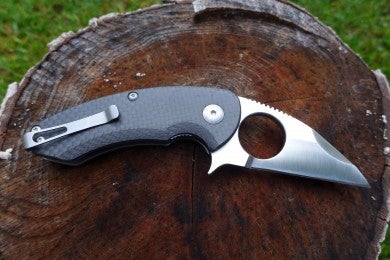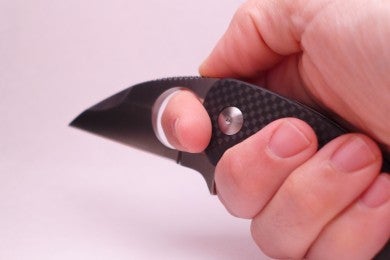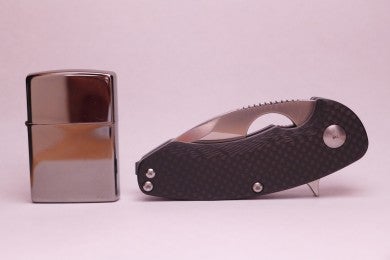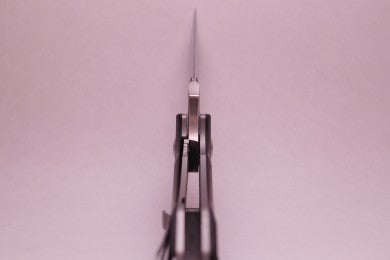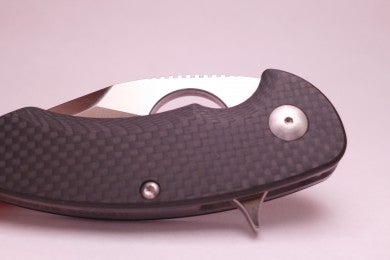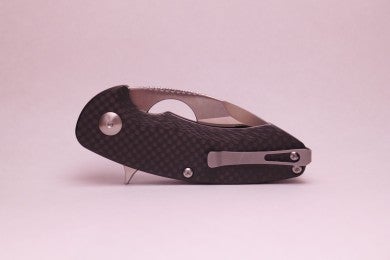Brous Blades Silent Soldier Flipper
Tony Sculimbrene 09.25.13
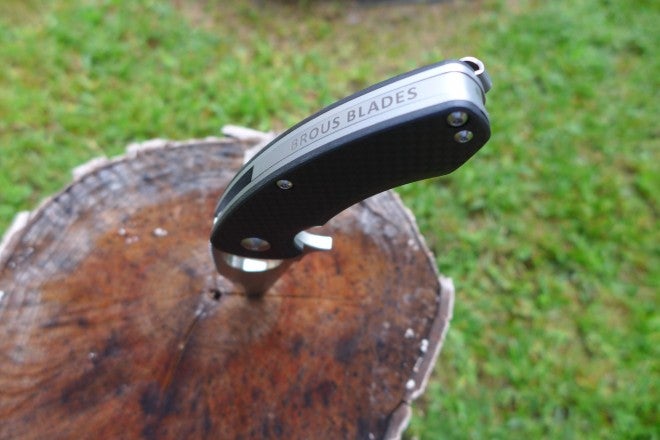
Everyone interested in knives has at least a passing desire to make their own. In secret, us knife knuts doodle out the perfect fixed blade or our preferred folder. On occasion some folks take the leap and actually make those doodles come to life.
Jason Brous is one such knife nut turned maker, and his Silent Soldier Neck Knife, with its distinctive finger holes and geometric lines, was a massive hit. From that starting point. Brous’s profile in the knife world rocketed into the stratosphere from small batch custom maker to a line of midtech blades and a deal with SOG in something like three years.
The most pocket friendly of all his designs is the Silent Soldier Flipper. It ports over many of the lines and features of the original neck knife into a folder design. The SSF v.2 has just been released and it’s a small batch (500) run of gorgeous midtech blades. Brous sent me a review sample, and over the past two weeks I have had a chance to look at the SSF up close. That examination demonstrates why Brous’s rise has been so meteoric. This is a clever and functional design with truly superlative fit and finish. There are a few minor quibbles, but on the whole, this is a worthy contender in the crowded market of high-end EDC knives.
Description
The Silent Soldier Flipper is a mid-sized wharncliffe style folding knife. It opens with a flipper and the blade rides on ball bearings around the pivot.
There are two models: a framelock ($399.99) and a linerlock ($279.99). The handle scales on both sides of the linerlock are smooth carbon fiber. The show side scale on the framelock is carbon fiber, and the lock in both designs is composed of titanium. The blade itself is a 2.7 inch blade with a 2.1 inch cutting edge. The v.2 model abandoned the “Q” style pocket clip in favor of a smaller and more discrete deep carry pocket clip.
Brous describes his style as “biomech”, and while that doesn’t seem far off, there is a strong geometric feel to the SSF with its arc shape, circular finger hole, and angular blade. The flipper is a push, as opposed to a pull, flipper, meaning that you push it down instead of pulling it back to deploy the knife. There is a run of very good and aesthetically cohesive jimping along the spine of the knife. Given the grip on the knife, the jimping is probably unnecessary. Even without it, only death or your desire could take this knife out of your hand.
The major carry over from the Silent Soldier Neck Knife, the finger hole, occupies a prominent place on the blade, and in hand it gives you an unparalleled amount of control over the blade and grip security. This is a grip with a knife built around it instead of the other way around. The SSF is perhaps the very epitome of form following function.
Testing
I carried the knife for two weeks, and in that time I carried it exclusively with the exception of two days. I did normal EDC chores with it: opening boxes and slicing open packages. I also did some whittling and heavy cardboard cutting with it. As the heat abated, we used our fire pit more often, and this gave me an excellent chance to really put knives through their paces. I made fuzz sticks and shavings to start the fire, and whittled cooking sticks once it got going. I also used the knife for mild food prep tasks, such as peeling an apple and cutting cheese and grapes. These three sets of tasks, EDC chores, fire prep, and food prep, represent a very good cross section of tasks for an EDC knife.
Design
As I mentioned above, this is a grip with a knife built around it, and this is clearly and distinctly the strongest part of the SSF design. There is no folder I have used that locks into the hand better than the SSF.
Its finger hole affords a degree of control that rivals the best small knife I use, the Dragonfly II, and that knife is lacking the locked-in feel. The flipper is very long, and this does cause some problems with disengaging the lock. If you aren’t careful, the flipper will close on your thumb, and over time I wore out a portion of my thumb. Once I realized this, I was able to approach the lock differently, but the damage, however slight, was done. The new pocket clip is a smaller number than the “Q” clip from the original that curled around the pivot screw and drove some owners crazy with its bright and shiny look.
The blade stock is very thick for a knife of this size: 3/16″ of an inch. It means that this knife is not going to slice with the best EDC slicers. But the knife seems to be more focused on a self-defense role than other knives of this size. I’d prefer a slicer in my EDC knife, but others don’t and I get that.
The knife’s handle has a very gradual chamfer to it and it makes the knife extremely comfortable in the hand and welcoming to the touch. The arc shape is ingenious, affording a full four finger grip even without the use of the finger hole. For a knife this small, it really does fill your hand. Here is a size comparison between the SSF and a standard Zippo:
One thing that is noticeable about the SSF is its weight. 4.2 ounces is quite a bit for a knife of this size. A lot of that comes from the slab of D2 used as the blade, but the liners and scales are thick as well. This is a stocky, solid knife. It is a bit heavier than most of my EDC blades, but if you are going to do more hard use tasks, the SSF will handle them with ease. It is right at the borderline of being too heavy; it’s stocky, but not portly.
Implementation
Quite frankly the machining, fit, and finish of this knife are all stunning. Wanna see some insanely early lock-up?
Custom folks love early lock up. It is a sign of careful machining and tight tolerances, and it is a guarantee that the knife has a lot of space to “wear in” with use. I have never seen lock up this early on any knife I have ever handled, ever (lots of “evers”, but this is a crazy feat of machining). There is not an ounce, smidgeon, or scintilla of play in the blade. Even with the tiniest of grips on the blade tang, nothing moves.
The satin finish on the D2 is equally nice. There is a beautiful, lustrous shine on every surface. All of these things are very nice, but it is this that makes me rethink just what can be done with a midtech knife:
The carbon fiber was smooth and inviting. It is not textured and the weave is not tactile. Instead, this carbon fiber has that same feel as nice dominoes. They, like the handle scales, are gently rounded and have a bit of heft to them, maybe a bit more than your brain thinks an object of that size should weigh. The carbon fiber on the SSF is simply amazing. Oh, and the knife can get away with a slick handle scale because of the incredible grip the finger hole provides.
The only ding I can level against the SSF implementation-wise is the fact that the 3/16″ D2 steel is a bit thick as it approaches the edge. This knife has what feels like and behaves like a flat grind, and even if it is actually a hollow grind, it is simply too shallow of a hollow grind to make a difference. Reducing the 3/16″ stock as quickly as the SSF’s grind does means if you want slicing performance, you have to use a very pronounced hollow grind. In cutting cardboard and making fuzz sticks for the fire, the edge was noticeably poor at slicing. Again, this isn’t a slicer by design, but a pronounced hollow grind could have made this knife a better cutter. And even if it’s supposed to be more of a self-defense tool, all EDC blades work better if they can slice.
Some folks might complain about the steel given the price. D2 is a very hard steel, hitting 61-62 HRc with proper heat treating. It is also an older steel and is not a true stainless steel, lacking the requisite 14% chromium to qualify, but the reality is that D2 is an oldie but a goodie. If the master blade smith Bob Dozier likes it, it’s good enough for me.
The reality is that objective performance tests, like the CATRA machine, have shown that D2 hangs in there with some of the newer and more expensive steels. It bests N690, VG-10, 154CM, and some variants of S30V. Its not as expensive a steel as you’d expect in an almost $300 knife, but it is a damn good one.
Function
The SSF performed well in the easier EDC tasks. The grind was exceptionally keen at the edge, though it did get choked up on some of the more challenging tasks. As I referenced before, the thick stock combined with the grind will cause that. I will note that the D2 never showed even a speckle of rust, even after food prep. The flipper fires with authority and proves, yet again, that you don’t really need an auto now (though boy are they cool). The new pocket clip is excellent. It has the perfect amount of tension and is well placed. The knife deploys with a confident snap and it took a lot of effort to get it to do anything other than deploy fully.
The SSF really does lap the field when it comes to in-hand feel, both because of the grip-centric design and because of the amazing carbon fiber. I have no experience with knife fights (thankfully), but in terms of cutting, you get an incredible amount of security and precision even in close, high pressure cuts. Nothing I have used, held, or reviewed can match the SSF’s grip. It is truly a game changer.
This is a knife absolutely worth considering when looking at the Sebenzas and Strider PTs of the world. Its fit and finish is in the same league as those knives, and its unique design breaks out of the dull repetition of one more gray, metal handled knife. This is not the best slicer in the world and it is a tad heavy, but it works well as an EDC knife. The limited run of 500 units will be gone soon, and if the v.1 was any indication, people will be clamoring for them on the secondary market.
